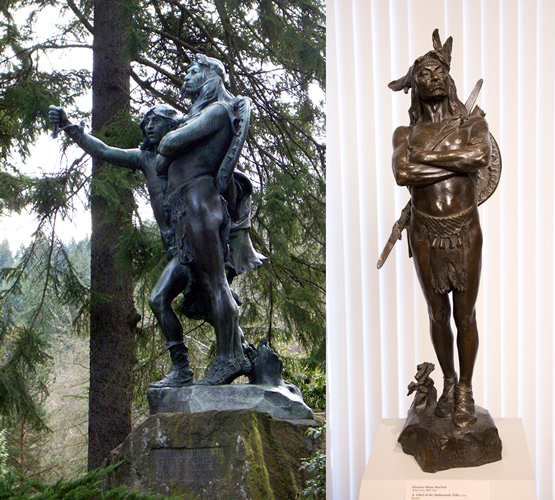Coming of the White Man / Chief Multnomah
Hermon Atkins MacNeil (1866–1947)
Left: Uploaded to commons.wikimedia.org by EncMstr. Licensed under the Creative Commons Attribution-Share Alike 3.0 Unported license.
Right: Courtesy Minneapolis Institute of Art, Gift of Donald and Louise Gabbert, 91.120.3. No copyright.
Hermon Atkins MacNeil’s list of works include the Standing Liberty Quarter minted between 1916 and 1930, Civil War Soldier’s Monument (Philadelphia, 1921), George Rogers Clark statue (Vincennes, 1934), Jacques Marquette bas-reliefs (Chicago, 1894), and the Pony Express Monument (St. Joseph, 1940).[1]“Hermon Atkins MacNeil,” Wikipedia, https://en.wikipedia.org/wiki/Hermon_Atkins_MacNeil accessed on 9 February 2021.
When interviewing William Clark and George Shannon to prepare his condensation of the expedition journals, Nicholas Biddle wrote in his notes that “The Multnomah nation is placed on the Wappatoe Island opposite the mouth of the Multh. river and the inlet which forms the island. . . . the neighbors speak of the Multnomah nations as great &c.”[2]The Nicholas Biddle Notes, c. April 1810 in Letters of the Lewis and Clark Expedition with Related Documents: 1783-1854, 2nd ed., ed. Donald Jackson (Urbana: University of Illinois Press, 1978), 542. They were also named, after their primary crop, the Wapato or Wappatoo Indians.
The Multnomahs spoke the Clackamas dialect and did have several villages on Sauvie Island as described by Lewis and Clark. Other villages identified by Lewis and Clark including Nahpooitle—often called Cathlapotle—in present-day Ridgefield National Wildlife Refuge, Shoto on Vancouver Lake, and Ničáqwli located at Portland International Airport.[3]Michael Silverstein, Handbook of North American Indians: Northwest Coast Vol. 7, ed. Wayne Suttles, (Washington, D.C.: Smithsonian Institution, 1990), 534.
In one of the rare depictions of Multnomah people, artist Hermon Atkins MacNeil created the “Coming of the White Man” likely at the request of Portland Mayor David P. Thompson. The work was installed in Portland’s City Park—now Washington Park—prior to the 1905 Lewis and Clark Centennial Exposition. Several bronzes of various smaller sizes were also made, one of which is shown in the figure on the right. It is said that the two men are looking toward the Columbia River at the arrival of the Lewis and Clark Expedition. In the bronze, the artist removed the second figure—said to be a medicine man—and added a feather headdress, bow, and quiver of arrows resulting in the figure looking more like a defiant Plains Indian than Lower Chinook.[4]Thayer Tolles and Thomas Brent Smith, et al. The American West in Bronze, The Metropolitan Museum of Art (New Haven: Yale University Press, 2013), 44–45.
In researching his work, MacNeil appears to have consulted anthropologist Frederick W. Hodge. Of the Multnomah, Hodge wrote:
Nē’maLnōmax, ‘down river’. A Chinookan tribe or division formerly living on the upper end of Sauvies id., Multnomah co., Oreg. In 1806 they were estimated at 800, but by 1835, according to Parker, they were extinct as a tribe. The term is also used in a broader sense to include all the tribes living on or near lower Willamette r., Oreg.[5]Frederick Webb Hodge, Handbook of American Indians North of Mexico, Vol. 1 (Washington: Smithsonian Institution Bureau of American Ethnology, 1912), 956.
As Multnomah populations declined from diseases, they absorbed into other tribes. In 1907, their population was given as ten people.[6]Robert H. Ruby, John A. Brown, and Cary C. Collins, A Guide to the Indian Tribes of the Pacific Northwest (Norman: University of Oklahoma Press, 2010), 202.
Selected Encounters
November 4, 1805
Busy day, noisy night
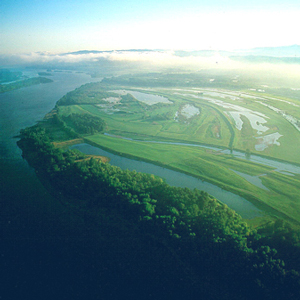

Near Ridgefield, WA The boats follow the Columbia River as it turns north at present-day Portland, Oregon. A Chinookan Indian invites the captains into his lodge, and they are introduced to the wapato bulb—a staple Indian food. They are visited by numerous Indians and kept awake by noisy waterfowl.
November 5, 1805
River crowded with Indians
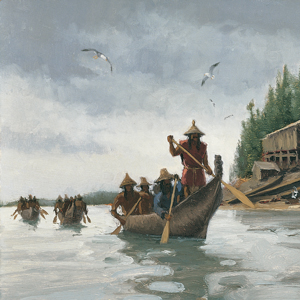

Near Prescott, OR After a night made sleepless by noisy waterfowl, the expedition heads down the Columbia. They pass the large village known today as Cathlapotle and encounter various Indians. In eastern Colorado, a Spanish force trying to stop the expedition is attacked.
March 28, 1806
Deer hunting
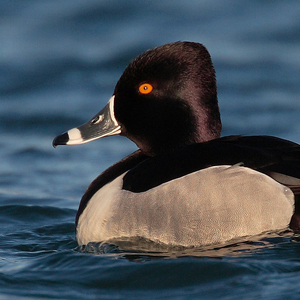

The main group joins the hunters who are on Deer Island in present Oregon. They spend the day hunting or repairing leaky dugout canoes. Lewis describes the red-sided garter snake and ring-necked duck.
March 29, 1806
Nahpooitle Village


They paddle fifteen miles up the Columbia and encamp near present Ridgefield, Washington. The captains describe the dress, houses, wapato trade, and customs of the Nahpooitle (Cathlapotle) villagers.
March 30, 1806
Prospects for a settlement


As they paddle through an area dense with Multnomah and Watlala villages, they see Cascade Mountain snow peaks, fertile land, and the best prospect for a large settlement west of the Rocky Mountains.
April 2, 1806
Exploring the Willamette River
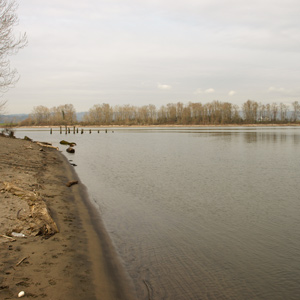

Clark sets out to find the Multnomah River and at its mouth, resorts to trickery to entice Indians to trade for food. At Provision Camp, Lewis says the berries are all gone except for the Oregon grape.
April 3, 1806
Mapping the Willamette River
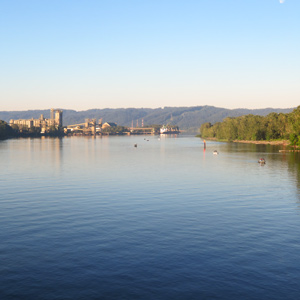

Clark concludes his exploration of the Willamette River and learns that a smallpox epidemic had devastated the local population. At Provision Camp, Lewis demonstrates the air gun as a defensive measure.
April 4, 1806
Hunting parties


At Provision Camp near present Washougal, Washington, the captains coordinate various hunting parties. Many “parties of the natives” visit, and Lewis takes astronomical observations.
Notes
| ↑1 | “Hermon Atkins MacNeil,” Wikipedia, https://en.wikipedia.org/wiki/Hermon_Atkins_MacNeil accessed on 9 February 2021. |
|---|---|
| ↑2 | The Nicholas Biddle Notes, c. April 1810 in Letters of the Lewis and Clark Expedition with Related Documents: 1783-1854, 2nd ed., ed. Donald Jackson (Urbana: University of Illinois Press, 1978), 542. |
| ↑3 | Michael Silverstein, Handbook of North American Indians: Northwest Coast Vol. 7, ed. Wayne Suttles, (Washington, D.C.: Smithsonian Institution, 1990), 534. |
| ↑4 | Thayer Tolles and Thomas Brent Smith, et al. The American West in Bronze, The Metropolitan Museum of Art (New Haven: Yale University Press, 2013), 44–45. |
| ↑5 | Frederick Webb Hodge, Handbook of American Indians North of Mexico, Vol. 1 (Washington: Smithsonian Institution Bureau of American Ethnology, 1912), 956. |
| ↑6 | Robert H. Ruby, John A. Brown, and Cary C. Collins, A Guide to the Indian Tribes of the Pacific Northwest (Norman: University of Oklahoma Press, 2010), 202. |
